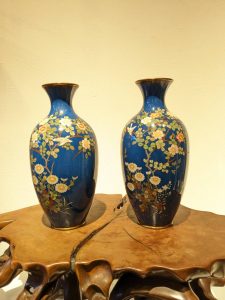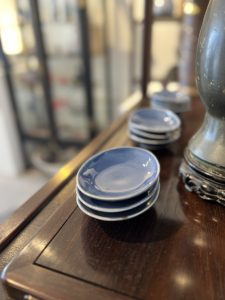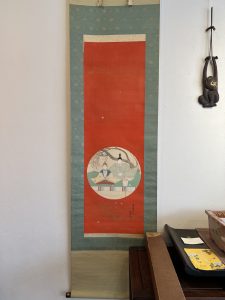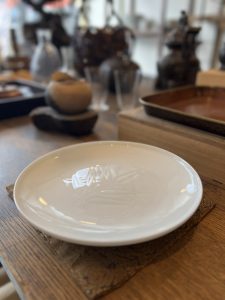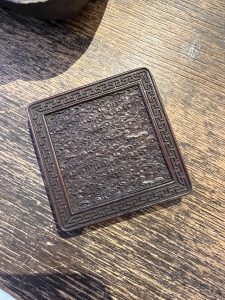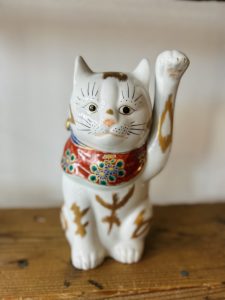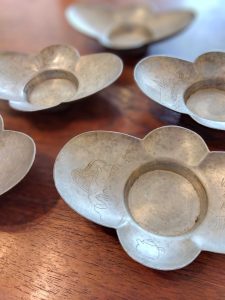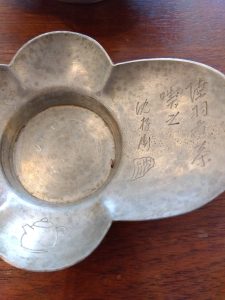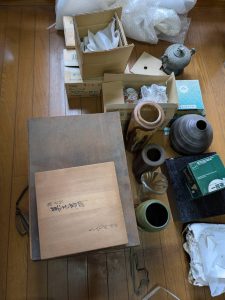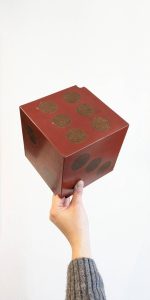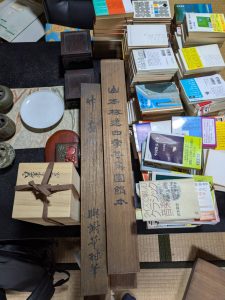突然の断水で実感したこと(愛知県名古屋市千種区姫池通 骨董買取 古美術風光舎)
2025.02.08
今朝は名古屋でも雪景色が広がっておりました。足元に気を付けながら歩いたせいか、体中がこわばっている気がいたします。みなさま安全にお過ごしください。
寒さによる水道の凍結なども心配なところですが、先週末、我が家では寒さとは関係なく突然断水となりました。午後6時頃に夕食の支度をしようとキッチンに立ったところ、蛇口から水が出ません。しばらく状況が飲み込めず、呆然と蛇口を眺めておりました。あまりにも驚くと思考がストップするものなのですね。
点検などの予告のある断水でしたら色々と準備もできるのですが、突然ですとただただ混乱し、週末でぼんやりしていた頭が覚醒しました。
予告はなかったよね?断水はこの地域全体?我が家だけ?それともこのマンションだけ?と「?」で頭が一杯になりました。
結局マンションの貯水タンクの不具合が原因だと判明したのですが、原因が分かると次は、夕食に食べられるものは?お風呂は無理だよね、今トイレは使用できる?などの心配事が次々と湧き、そして何よりも、いつまでこの断水が続くのかという不安に押しつぶされそうになります。
幸い6時間ほどで復旧しましたが、備蓄の水がみるみる減っていく不安もあり、水が出た瞬間は本当に安堵しました。
災害などによる断水や停電の情報を耳にするたび、その大変さを慮っておりましたが、当事者になる大変さを想像するなど不可能なことだと実感しました。
蛇口から水が出てくれることの有難さを身に染みて感じたからか、いつも何気なく通り過ぎていたモニュメントが目に留まりました。
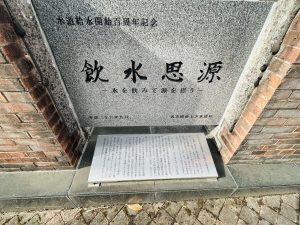
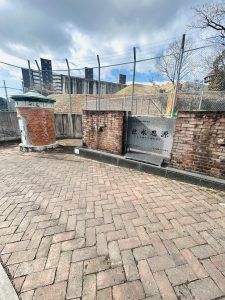
名古屋における「水道給水開始100年記念碑」で、東山配水場旧2号配水池の壁が再利用されています。この碑に刻まれている「飲水思源」とは中国北周の詩人の「徴調曲」に由来する成句で「水を飲むたびに水源のありがたさに思いを致す」、物事の基本を忘れないことのたとえと記されています。
また隣には当時の水位計室も移設されています。レトロな雰囲気が漂っています。
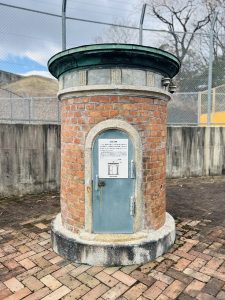
以前から気になっていたモニュメントの奥にそびえ立っている、とんがり帽子の建物。何度見ても「ムーミンの家」を思い起こさせます。
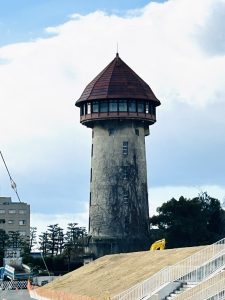
こちらは1930年に「東山給水塔」として建設され、1973年まで覚王山一帯の高台に配水するために利用されました。現在は災害対策用の応急給水施設として水を蓄えています。
そして道路を挟んだ向かい側には名古屋の上下水道の歴史や防災について学習できる「水の歴史資料館」があります。2014年に設立され、なんと入場は無料となっております。
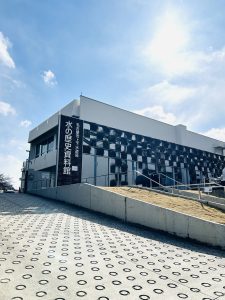
屋外にも創成期の仕切弁や名古屋市の歴代のマンホールの蓋などが展示され、館内には「江戸時代の上下水道」や当時の「下水道啓発ポスター」など様々な装置や資料が展示されているようで、入館したい衝動に駆られましたが、お仕事がありますので諦めました。機会のある方はぜひ訪れてみてください。
またこの辺りには「水の歴史プロムナード」と名づけられた遊歩道もございます。お散歩には最適のコースで、ここにも昭和6年ころに使用されていた「Y字菅」が展示されています。

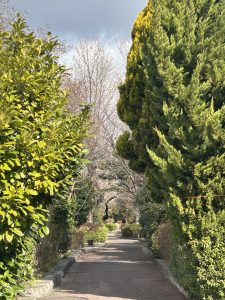
日本の近代水道は明治20年に横浜に「野毛山浄水上場」が誕生したことに始まると言われています。
明治時代初め、鉄道や建築における技術発展の裏で水道の整備は進まず、水質が悪化によりコレラなどの感染病が大流行しました。そこで日本の近代水道の父と呼ばれるイギリス人のへンリー・スペンサー・パーマーの指導によりポンプを使った浄水場が横浜に作られ、その後都市部を中心に急速に広がったとされています。
驚いたことに現在世界で水道が普及している国は196カ国中、50カ国以下で、全国土で水道水が飲める国は15カ国しかないとか。飲める水道水を作るには、それだけ高い浄水技術とコストが必要なのですね。清潔な水を日常的に使用できるのは奇跡と言えるのかもしれません。
ただ日本の水道システムも老朽化が進み、これまで水道事業を担ってきた技術面でのノウハウを持つ職員が高齢化しているといいます。
また農薬や化学物質、マイクロプラスチックの流出なども水質汚染の原因となり、水道管を傷める要因ともなります。
喉元過ぎれば熱さを忘れる、ということにならないよう蛇口から当たり前のように清潔な水を得られることに感謝し、下水に流れていく水にも意識を向けなくてはなど、水に思いを馳せた1週間でありました。
それでは、また次の機会に(スタッフH)
This morning there was snow on the ground in Nagoya. I feel stiff, perhaps because I had to watch my step as I walked. Please be safe everyone.
We are worried about the freezing water supply due to the cold weather, but last weekend, our water supply was suddenly cut off regardless of the cold weather. When I stood in the kitchen around 6:00 p.m. to prepare dinner, there was no water coming out of the faucet. For a while, I couldn’t swallow the situation and looked at the faucet in amazement. I guess when you are so surprised, you stop thinking.
If the water was cut off with an inspection or some other warning, I would be prepared for anything, but when it happened suddenly, I was simply confused and my head, which had been foggy over the weekend, was awakened.
There was no warning, right? Was the water cut off for the whole area? Just our house? Or just this apartment? And “? I was filled with “What’s wrong with the water?
In the end, it turned out to be due to a problem with the water storage tank in the apartment, but once I figured out the cause, the next question was, “What can we eat for dinner? I can’t take a bath, can I use the toilet now? And most of all, I was almost crushed by the anxiety of how long this water cutoff would last.
Fortunately, the water supply was restored in about six hours, but I was very relieved when the water supply was restored, as I was anxious that the stockpiled water was dwindling fast.
Whenever I heard about water and power outages due to disasters, I always thought about how difficult it would be, but I realized that it would be impossible to imagine how difficult it would be to be a party to such an event.
Perhaps it was because I was so grateful to have water running from my faucet that a monument that I had always casually passed by caught my eye.
It is a monument commemorating the 100th anniversary of the start of water supply in Nagoya, and the wall of the former No. 2 distribution pond at the Higashiyama Distribution Center has been reused. The inscription on the monument reads “Yinsuishigen”, a phrase from the “Chou Chou Kyoku” by a poet of the Northern Zhou Dynasty in China, which means “Every time you drink water, think of how grateful you are for the source of water”, a metaphor for remembering the basics of things.
The water level gauge room from those days has also been relocated next to the building. It has a retro atmosphere.
The pointy hat building standing tall at the back of the monument has been on my mind for a long time. No matter how many times I see it, it reminds me of “Moomin’s House.
This building was built in 1930 as the “Higashiyama Water Tower” and was used to distribute water to the higher ground in the Kakuozan area until 1973. Currently, the water is stored as an emergency water supply facility for disaster countermeasures.
The Water History Museum, which was established in 2014, is located across the street, and admission is free.
Inside the museum, there are exhibits such as “Water and Sewerage in the Edo Period” and “Sewerage Awareness Posters” from that time. If you have a chance, please visit the museum.
There is also a promenade named “Water History Promenade” in this area. It is an ideal course for a stroll, and a “Y-jun kan” used around 1931 is on display here as well.
It is said that Japan’s modern waterworks began with the establishment of the “Nogeyama Water Purification List” in Yokohama in 1887.
At the beginning of the Meiji Era (1868-1912), while technological development in railroads and construction was progressing, the water supply system was not, and infectious diseases such as cholera broke out due to deteriorating water quality. Under the guidance of Englishman Henley Spencer Palmer, known as the father of modern Japanese waterworks, a water purification plant using pumps was built in Yokohama, and the system rapidly spread to urban areas.
Surprisingly, less than 50 of the 196 countries in the world currently have tap water, and there are only 15 countries in the entire land where tap water is drinkable. It takes such a high level of water purification technology and cost to produce drinkable tap water. It may be a miracle that clean water is available on a daily basis.
However, Japan’s water supply system is aging, and the staff with the technical expertise that has been responsible for the water supply business is said to be getting older.
Pesticides, chemicals, and microplastic runoff also cause water pollution and damage water pipes.
It has been a week of thinking about water, and I am grateful for the clean water we take for granted from our faucets, and I am also conscious of the water that goes down the drain.
See you next time (Staff H)
*****************
ご実家の整理やお片付けなどをされている方のご相談などが多くございます。
お片付けなどくれぐれもご無理のないようになさってくださいませ。
風光舎では古美術品や骨董品の他にも絵画や宝石、趣味のお品など様々なジャンルのものを買受しております。
お片付けをされていて、こういうものでもいいのかしらと迷われているものでも、どうぞお気軽にご相談下さいませ。
また風光舎は、出張買取も強化しております。ご近所はもちろん、愛知県内、岐阜県、三重県その他の県へも出張いたします。
まずは、お電話お待ちしております。
愛知県名古屋市千種区姫池通
骨董 買取【古美術 風光舎 名古屋店】
TEL052(734)8444
10:00-18:00 OPEN
#出張買取#骨董#古美術#骨董品#絵画#版画#茶道具#刀剣#彫刻

